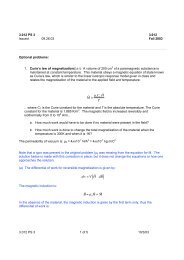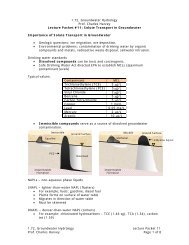1.72, Groundwater Hydrology Prof. Charles Harvey Lecture Packet #3
1.72, Groundwater Hydrology Prof. Charles Harvey Lecture Packet #3
1.72, Groundwater Hydrology Prof. Charles Harvey Lecture Packet #3
Create successful ePaper yourself
Turn your PDF publications into a flip-book with our unique Google optimized e-Paper software.
<strong>1.72</strong>, <strong>Groundwater</strong> <strong>Hydrology</strong><br />
<strong>Prof</strong>. <strong>Charles</strong> <strong>Harvey</strong><br />
<strong>Lecture</strong> <strong>Packet</strong> <strong>#3</strong>: Hydraulic Head and Fluid Potential<br />
What makes water flow?<br />
Consider pressure<br />
Water Level<br />
C<br />
po<br />
Pressure at A = atmospheric (po)<br />
Pressure at B > atmospheric (po + ∆p)<br />
Pressure at C = atmospheric (po)<br />
But flow is not from A to B to C.<br />
Flow is not “down pressure gradient.”<br />
Hubbert (1940) – Potential<br />
po<br />
po + ∆p<br />
A<br />
Water Level<br />
A physical quantity capable of measurement at every point in a flow system,<br />
whose properties are such that flow always occurs from regions in which the<br />
quantity has less higher values to those in which it has lower values<br />
regardless of the direction in space.<br />
Examples:<br />
Heat conducts from high temperature to low temperature<br />
• Temperature is a potential<br />
Electricity flows from high voltage to low voltage<br />
• Voltage is a potential<br />
Fluid potential and hydraulic head<br />
Fluids flow from high to low fluid potential<br />
• Flow direction is away from location where mechanical energy per unit mass<br />
of fluid is high to where it is low.<br />
• How does this relate to measurable quantity?<br />
<strong>1.72</strong>, <strong>Groundwater</strong> <strong>Hydrology</strong> <strong>Lecture</strong> <strong>Packet</strong> 3<br />
<strong>Prof</strong>. <strong>Charles</strong> <strong>Harvey</strong> Page 1 of 9<br />
B
<strong>Groundwater</strong> flow is a mechanical process – forces driving fluid must overcome<br />
frictional forces between porous media and fluid. (generates thermal energy)<br />
Work – mechanical energy per unit mass required to move a fluid from point z to<br />
point z’.<br />
Elevation: z’<br />
Pressure: p<br />
Velocity: v<br />
Density: ρ<br />
Volume: V<br />
Elevation: z=0<br />
Pressure: p=po<br />
Velocity: vo<br />
Density: ρo<br />
Volume: Vo<br />
z’<br />
z<br />
Fluid potential<br />
is mechanical<br />
energy per unit<br />
mass = work<br />
to move unit<br />
mass<br />
<strong>1.72</strong>, <strong>Groundwater</strong> <strong>Hydrology</strong> <strong>Lecture</strong> <strong>Packet</strong> 3<br />
<strong>Prof</strong>. <strong>Charles</strong> <strong>Harvey</strong> Page 2 of 9
Which way does water flow (function of Z and P) ?<br />
hp1<br />
z1<br />
hp1<br />
z1<br />
Q<br />
Q<br />
hp2<br />
z2<br />
hp2<br />
z2<br />
Fluid potential is the mechanical energy per unit mass of fluid potential at z’ = fluid<br />
potential at datum + work from z to z’.<br />
The work to move a unit mass of water has three components:<br />
1) Work to lift the mass (where z = 0)<br />
w 2 = mgz'<br />
2) Work to accelerate fluid from v=0 to v’<br />
w 2<br />
=<br />
2<br />
mv<br />
2<br />
hp1<br />
hp1<br />
3) Work to raise fluid pressure from p=po to p<br />
p p p<br />
z1<br />
V dp<br />
w3 = ∫Vdp = m∫ dp = m∫ m p<br />
po po po<br />
<strong>1.72</strong>, <strong>Groundwater</strong> <strong>Hydrology</strong> <strong>Lecture</strong> <strong>Packet</strong> 3<br />
<strong>Prof</strong>. <strong>Charles</strong> <strong>Harvey</strong> Page 3 of 9<br />
z1<br />
Q<br />
Q<br />
hp2<br />
z2<br />
hp2<br />
z2
Note that a unit mass of fluid occupies a volume V = 1/ρ<br />
The Fluid Potential (the mechanical energy per unit mass, m=1)<br />
φ = gz + v + ∫ dp +<br />
2 p<br />
p o<br />
2<br />
φ = gz + v<br />
2 +<br />
2<br />
p<br />
p −<br />
p<br />
p<br />
0<br />
for incompressible fluid (ρ is constant)<br />
This term is almost always unimportant in groundwater<br />
flow, with the possible exception of where the flow is very<br />
fast, and Darcy’s Law begins to break down.<br />
How does potential relate to the level in a pipe?<br />
At a measurement point pressure is described by:<br />
P = ρ g(depth) + po<br />
p = ρ gϕ + po<br />
p = ρ g(h-z) + po<br />
Return to fluid potential equation<br />
2<br />
− 0<br />
φ = gz + v p p<br />
+<br />
2 p<br />
Neglect velocity (kinetic) term, and substitute for p<br />
So,<br />
ρ g ( h − z ) + 0<br />
φ = gz +<br />
ρ<br />
p − 0 p<br />
φ = gh or h = φ / g<br />
Thus, head h is a fluid potential.<br />
<strong>1.72</strong>, <strong>Groundwater</strong> <strong>Hydrology</strong> <strong>Lecture</strong> <strong>Packet</strong> 3<br />
<strong>Prof</strong>. <strong>Charles</strong> <strong>Harvey</strong> Page 4 of 9<br />
ϕ<br />
z<br />
h
• Flow is always from high h to low h.<br />
• H is energy per unit weight.<br />
• H is directly measurable, the height of water above some point.<br />
Thermal Potential<br />
h = z + ϕ<br />
ϕt = Thermal Potential<br />
Temperature can be an important driving force for groundwater and soil moisture.<br />
• Volcanic regions<br />
• Deep groundwater<br />
• Nuclear waste disposal<br />
Can cause heat flow and also drive water.<br />
Chemical Potential<br />
Adsorption Potential<br />
Total Potential is the sum of these, but for saturated conditions for our initial cases<br />
we will have:<br />
*<br />
q = − L1<br />
ϕ = ϕg + ϕp<br />
∂ h ∂ T<br />
− L2<br />
∂ l ∂ l<br />
Derivation of the <strong>Groundwater</strong> Flow Equation<br />
Darcy’s Law in 3D<br />
Homogeneous vs. Heterogeneous<br />
Isotropic vs. Anisotropic<br />
L<br />
− 3<br />
Isotropy – Having the same value in all directions. K is a scalar.<br />
K<br />
∂ c<br />
∂ l<br />
h<br />
∂h ∂ h<br />
K<br />
x<br />
∂y ∂ z<br />
∂<br />
= −<br />
= − K = − K<br />
∂<br />
q x q y q z<br />
Anisotropic – having directional properties. K is really a tensor in 3D<br />
Gradient<br />
K<br />
Flow<br />
The value that converts one vector to another vector is a tensor.<br />
<strong>1.72</strong>, <strong>Groundwater</strong> <strong>Hydrology</strong> <strong>Lecture</strong> <strong>Packet</strong> 3<br />
<strong>Prof</strong>. <strong>Charles</strong> <strong>Harvey</strong> Page 5 of 9
y<br />
q = − K ∂ h ∂ h<br />
xx − K xy<br />
∂ x ∂ y − K ∂ h<br />
x<br />
xz<br />
∂ z<br />
q y = − K yx<br />
∂ h ∂ h ∂ h<br />
− K yy − K yz<br />
∂ x ∂ y ∂ z<br />
∂h ∂h<br />
∂ h<br />
= − K − K − K zz<br />
∂x ∂y<br />
∂ z<br />
qz zx zy<br />
• The first index is the direction of flow<br />
• The second index is the gradient direction<br />
Interpretation - Kxx is a coefficient along the x-direction that contributes a<br />
component of flux along the x-axis due to the coefficient along the z-direction that<br />
contributes a component of flux along the z-axis due to the component of the<br />
gradient in the y-direction.<br />
The conductivity ellipse (anisotropic vs. isotropic)<br />
K yy<br />
Gradient<br />
Flow y<br />
K xx<br />
x<br />
If Kyy = Kxx then the media is isotropic and ellipse is a circle.<br />
It is convenient to describe Darcy’s law as:<br />
q<br />
r = −<br />
K ∇ h<br />
K yy<br />
K xx<br />
Gradient<br />
Flow<br />
Where ∇ is called del and is a gradient operator, so ∇ h is the gradient in all three<br />
directions (in 3D). K is a matrix.<br />
<strong>1.72</strong>, <strong>Groundwater</strong> <strong>Hydrology</strong> <strong>Lecture</strong> <strong>Packet</strong> 3<br />
<strong>Prof</strong>. <strong>Charles</strong> <strong>Harvey</strong> Page 6 of 9<br />
x
qx =<br />
qy =<br />
qz =<br />
Kxx Kxy Kxz<br />
Kyx Kyy Kyz<br />
Kzx Kzy Kzz<br />
The magnitudes of K in<br />
conductivities.<br />
Kxx<br />
Kyy<br />
the principal directions<br />
If the coordinate axes are aligned with the principal directions of the conductivity<br />
tensor then the cross-terms drop out giving:<br />
qx =<br />
qy =<br />
qz =<br />
Kzz<br />
∂ h<br />
∂ x<br />
∂ h<br />
∂ y<br />
∂ h<br />
∂ z<br />
∂ h<br />
∂ x<br />
∂ h<br />
∂ y<br />
∂ h<br />
∂ z<br />
are known as the principal<br />
<strong>1.72</strong>, <strong>Groundwater</strong> <strong>Hydrology</strong> <strong>Lecture</strong> <strong>Packet</strong> 3<br />
<strong>Prof</strong>. <strong>Charles</strong> <strong>Harvey</strong> Page 7 of 9
Effective Hydraulic Conductivity<br />
Q1<br />
Qtot Q2<br />
Q3<br />
Q4<br />
Qtot = Q1 + Q2 + Q3 + Q4<br />
=<br />
=<br />
=<br />
∆H<br />
L 1 K<br />
∆ x<br />
∆<br />
∆ x<br />
∆ H<br />
∆ x<br />
1<br />
n H<br />
∑<br />
i<br />
L tot K eff<br />
∆Htot<br />
∆H<br />
∆H<br />
∆H<br />
+ L 2 K 2 + L 3 K 3 + L 4K 4<br />
∆ x ∆ x ∆ x<br />
L i K i<br />
∑<br />
i<br />
= n<br />
<strong>1.72</strong>, <strong>Groundwater</strong> <strong>Hydrology</strong> <strong>Lecture</strong> <strong>Packet</strong> 3<br />
<strong>Prof</strong>. <strong>Charles</strong> <strong>Harvey</strong> Page 8 of 9<br />
K<br />
eff<br />
n<br />
∑<br />
i<br />
L K<br />
i<br />
L<br />
i<br />
i<br />
Ltot
∆ Htot<br />
∆ Htot = ∆ H1 + ∆ H2 + ∆ H3 + ∆ H4<br />
Q<br />
∆ H1<br />
∆ H2<br />
∆ H3<br />
∆ H4<br />
∆ H tot ∆ H1 ∆ H 2 ∆ H 3<br />
q = K eff = K1 = K 2 = K 3 =<br />
L<br />
∆ H 4<br />
K 4<br />
tot L1 L2 L3 L4 n qL tot qL i<br />
∑ Li = ∑ i<br />
K eff i K i Keff = n<br />
∑ Li n<br />
i K i<br />
<strong>1.72</strong>, <strong>Groundwater</strong> <strong>Hydrology</strong> <strong>Lecture</strong> <strong>Packet</strong> 3<br />
<strong>Prof</strong>. <strong>Charles</strong> <strong>Harvey</strong> Page 9 of 9<br />
Ltot









